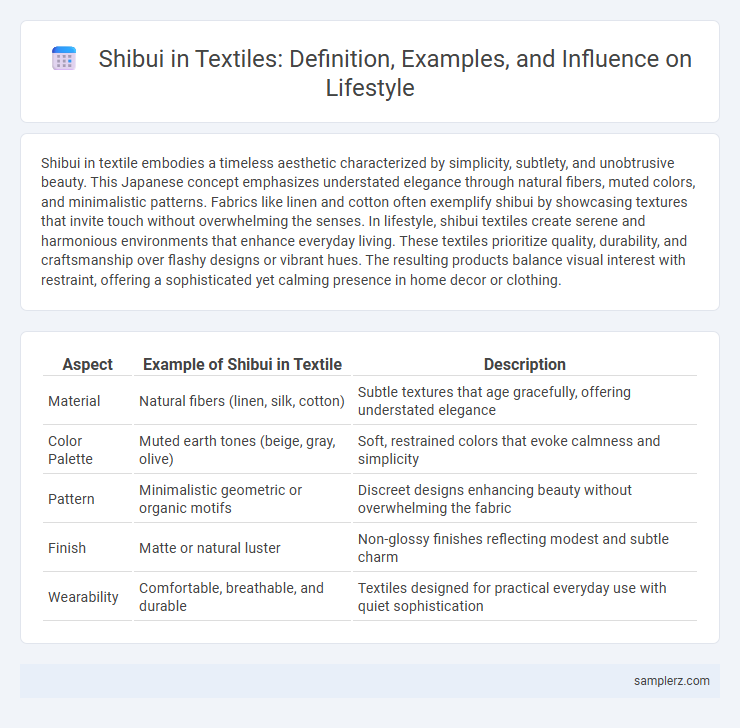Shibui in textile embodies a timeless aesthetic characterized by simplicity, subtlety, and unobtrusive beauty. This Japanese concept emphasizes understated elegance through natural fibers, muted colors, and minimalistic patterns. Fabrics like linen and cotton often exemplify shibui by showcasing textures that invite touch without overwhelming the senses. In lifestyle, shibui textiles create serene and harmonious environments that enhance everyday living. These textiles prioritize quality, durability, and craftsmanship over flashy designs or vibrant hues. The resulting products balance visual interest with restraint, offering a sophisticated yet calming presence in home decor or clothing.
Table of Comparison
| Aspect | Example of Shibui in Textile | Description |
|---|---|---|
| Material | Natural fibers (linen, silk, cotton) | Subtle textures that age gracefully, offering understated elegance |
| Color Palette | Muted earth tones (beige, gray, olive) | Soft, restrained colors that evoke calmness and simplicity |
| Pattern | Minimalistic geometric or organic motifs | Discreet designs enhancing beauty without overwhelming the fabric |
| Finish | Matte or natural luster | Non-glossy finishes reflecting modest and subtle charm |
| Wearability | Comfortable, breathable, and durable | Textiles designed for practical everyday use with quiet sophistication |
Introduction to Shibui: The Essence of Subtle Beauty in Textiles
Shibui in textiles embodies understated elegance through simple yet sophisticated design elements, balanced textures, and muted color palettes that evoke timeless beauty. Fabric choices such as handwoven silks, linen blends, and natural dyes highlight the essence of Shibui by emphasizing quality and subtle imperfections. This aesthetic merges functionality with quiet refinement, creating garments and furnishings that age gracefully and maintain enduring appeal.
Historical Influence of Shibui in Japanese Fabric Design
Shibui in Japanese textile design reflects a historical emphasis on simplicity, subtlety, and natural beauty, often seen in traditional fabrics such as kimono silks and indigo-dyed cottons. Techniques like kasuri and katazome demonstrate the restrained elegance and muted color palettes characteristic of shibui aesthetics, blending functional craftsmanship with refined artistry. This aesthetic philosophy has influenced modern fabric design by inspiring minimalist patterns and textures that maintain a deep cultural resonance and timeless appeal.
Characteristics of Shibui in Textile Patterns and Colors
Shibui in textile patterns embodies subtle complexity through understated colors like muted blues, grays, and earthy tones that evoke natural elements. The textures are often simple yet refined, blending smooth and slightly irregular weaves to create visual and tactile depth without overwhelming the senses. This balance of simplicity and intricate detail exemplifies the timeless elegance and restrained beauty central to shibui aesthetics in fabric design.
Shibui-Inspired Fabric Blends and Textures
Shibui-inspired fabric blends combine natural fibers such as silk, wool, and cotton to create understated textures that emphasize simplicity and subtle elegance. These textiles feature muted color palettes with soft contrasts, enhancing their timeless and refined aesthetic. The interplay of smooth and slightly rough textures embodies the shibui principle of minimalist beauty through functional, tactile quality.
Crafting Shibui: Traditional Techniques in Textile Production
Crafting shibui in textile production emphasizes subtle elegance through traditional dyeing methods like indigo and natural mordants, which create muted, complex hues and soft textures. Techniques such as kasuri weaving and boro patchwork embody wabi-sabi aesthetics by valuing imperfection and simplicity, resulting in timeless, understated fabrics. Artisans rely on slow, deliberate processes that highlight the beauty of natural fibers and the harmony of color and form, ensuring each piece reflects deep cultural heritage.
Contemporary Shibui: Modern Designers Embracing Simplicity
Contemporary Shibui in textiles exemplifies a refined aesthetic through minimalist design, natural fibers, and subtle color palettes that evoke calmness and understated elegance. Modern designers prioritize quality craftsmanship and functional beauty, emphasizing texture and form over ornate patterns. This approach aligns with the Shibui principle of achieving deep richness through simplicity, fostering timeless, versatile garments in today's lifestyle.
Iconic Examples of Shibui in Kimono and Yukata Textiles
Classic kimono and yukata textiles showcase shibui through subtle patterns such as delicate kasuri weaving and understated indigo dyeing techniques. The use of muted color palettes combined with minimalist geometric or nature-inspired motifs exemplifies a refined aesthetic that balances simplicity and complexity. Iconic examples include traditional tsumugi silk kimonos and cotton yukatas featuring softly blurred ikat designs, embodying the timeless elegance of shibui in Japanese textile art.
How to Identify Shibui Qualities in Everyday Fabrics
Shibui qualities in everyday fabrics can be identified through subtle textures, muted color palettes, and understated patterns that embody simplicity and elegance. Look for natural fibers like cotton, linen, or silk that age gracefully, developing character over time without flashy embellishments. The fabric's craftsmanship subtly reveals an aesthetic balance between plainness and complexity, inviting a calm and refined sensory experience.
Shibui Aesthetics in Sustainable Textile Choices
Shibui aesthetics in sustainable textile choices emphasizes understated elegance, natural textures, and muted colors, reflecting a balance between simplicity and subtle complexity. Fabrics like organic linen, hemp, and undyed cotton embody this philosophy by showcasing their inherent qualities without excessive processing or embellishment. Choosing these materials supports eco-friendly practices while enhancing a wardrobe with timeless, refined pieces that age gracefully.
Incorporating Shibui Textiles into Home and Fashion Styles
Incorporating Shibui textiles into home and fashion styles emphasizes understated elegance through muted colors, simple patterns, and natural materials like linen and cotton. These textiles enhance spaces and wardrobes with subtle sophistication that harmonizes with minimalist and wabi-sabi aesthetics. Embracing Shibui fabric fosters a timeless, calm atmosphere that values quality and restraint over ostentation.

example of shibui in textile Infographic
 samplerz.com
samplerz.com